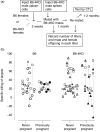Maternal tolerance is not critically dependent on interleukin-4
- PMID: 11454068
- PMCID: PMC1783238
- DOI: 10.1046/j.1365-2567.2001.01239.x
Maternal tolerance is not critically dependent on interleukin-4
Abstract
Pregnant animals can generate and maintain immune responses to fetal antigens. This however, does not usually lead to fetal loss. At least two types of immune response are recognized. T helper type 1 (Th1) responses support the generation of cellular cytotoxicity. In contrast, Th2-type responses support the production of non-cytotoxic antibody and suppress the Th1-type. One attempt to explain why the fetus is not generally rejected has been to suggest that during pregnancy Th2-type responses are dominant. These responses rely heavily on interleukin-4 (IL-4) for both functions. This work focuses on maternal immunity to the male antigen H-Y, which is expressed in male fetuses. When injected with male spleen cells, female mice of certain strains mount a cytotoxic immune response to H-Y. However, pregnant females immunized in this way do not deliver litters with fewer males. To help delineate the possible role of IL-4 in such maternal tolerance, female mice genetically deficient in IL-4 were studied. The results show that: (1) deficiency in maternal IL-4 does not affect fertility, (2) deficiency in IL-4 is not associated with selective loss of male offspring in unimmunized mice, (3) pregnancy does not obliterate anti-H-Y reactivity in immunized mice and (4) maternal immunity to H-Y in the absence of IL-4 does not result in loss of male offspring. The results suggest that IL-4-dependent Th2-type responses are not critical to maternal tolerance. Other cytokines must be examined for their role in this phenomenon.
Figures




Similar articles
-
Maternal tolerance to H-Y is independent of IL-10.Immunol Invest. 2004;33(4):385-95. doi: 10.1081/imm-200032732. Immunol Invest. 2004. PMID: 15624697
-
The H-Y response in mid-gestation and long after delivery in mice primed before pregnancy.Immunol Invest. 2003 Feb;32(1-2):71-81. doi: 10.1081/imm-120019209. Immunol Invest. 2003. PMID: 12722943
-
Maternal T cells of immunized pregnant mice induce immune suppression in their offspring.Immunology. 1992 Oct;77(2):171-6. Immunology. 1992. PMID: 1427971 Free PMC article.
-
The Role of Extracellular Vesicles and PIBF in Embryo-Maternal Immune-Interactions.Front Immunol. 2018 Dec 13;9:2890. doi: 10.3389/fimmu.2018.02890. eCollection 2018. Front Immunol. 2018. PMID: 30619262 Free PMC article. Review.
-
The H-Y antigen and its role in natural transplantation.Hum Genet. 1981;58(1):9-17. doi: 10.1007/BF00284141. Hum Genet. 1981. PMID: 7026417 Review.
Cited by
-
Aerobic Vaginitis Induced by Escherichia coli Infection During Pregnancy Can Result in Adverse Pregnancy Outcomes Through the IL-4/JAK-1/STAT-6 Pathway.Front Microbiol. 2021 Apr 7;12:651426. doi: 10.3389/fmicb.2021.651426. eCollection 2021. Front Microbiol. 2021. PMID: 33897665 Free PMC article.
-
Dendritic cells: a family portrait at mid-gestation.Immunology. 2009 Apr;126(4):565-78. doi: 10.1111/j.1365-2567.2008.02918.x. Epub 2008 Sep 5. Immunology. 2009. PMID: 18778288 Free PMC article.
-
Animal Models of Preeclampsia: Mechanistic Insights and Promising Therapeutics.Endocrinology. 2022 Aug 1;163(8):bqac096. doi: 10.1210/endocr/bqac096. Endocrinology. 2022. PMID: 35772781 Free PMC article. Review.
-
Fetal death: an extreme manifestation of maternal anti-fetal rejection.J Perinat Med. 2017 Oct 26;45(7):851-868. doi: 10.1515/jpm-2017-0073. J Perinat Med. 2017. PMID: 28862989 Free PMC article.
-
Effector and Activated T Cells Induce Preterm Labor and Birth That Is Prevented by Treatment with Progesterone.J Immunol. 2019 May 1;202(9):2585-2608. doi: 10.4049/jimmunol.1801350. Epub 2019 Mar 27. J Immunol. 2019. PMID: 30918041 Free PMC article. Clinical Trial.
References
-
- Clark DA, McDermott MR, Szewczuk MR. Impairment of host-versus-graft reaction in pregnant mice II. Selective suppression of cytotoxic T-Cell generation correlates with soluble suppressor activity and with successful allogeneic pregnancy. Cell Immunol. 1980;52:106–18. - PubMed
-
- Billingham RES. Studies on the tolerance of the Y chromosome antigen in mice. J Immunol. 1960;85:14–26. - PubMed
-
- Kaliss N, Dagg MK. Immune response engendered in mice by mulitiparity. Transplantation. 1964;2:416–25. - PubMed
-
- Breyere EJ, Barrett MK. Tolerance induced by parity in mice incompatible at the H-2 locus. J Natl Can Inst. 1961;27:409–12.
-
- Tafuri A, Alferink J, Moller P, Hammerling GJ, Arnold B. T Cell awareness of paternal alloantigens during pregnancy. Science. 1996;270:630–3. - PubMed
Publication types
MeSH terms
Substances
LinkOut - more resources
Full Text Sources

